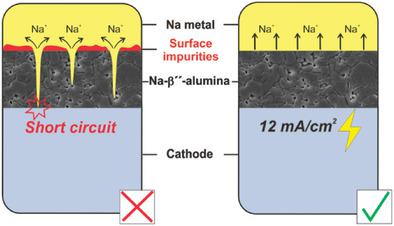当前位置:
X-MOL 学术
›
Adv. Energy Mater.
›
论文详情
Our official English website, www.x-mol.net, welcomes your feedback! (Note: you will need to create a separate account there.)
Sodium Plating from Na‐β″‐Alumina Ceramics at Room Temperature, Paving the Way for Fast‐Charging All‐Solid‐State Batteries
Advanced Energy Materials ( IF 27.8 ) Pub Date : 2019-12-04 , DOI: 10.1002/aenm.201902899 Marie‐Claude Bay 1, 2 , Michael Wang 3 , Rabeb Grissa 1 , Meike V. F. Heinz 1 , Jeff Sakamoto 3, 4 , Corsin Battaglia 1
Advanced Energy Materials ( IF 27.8 ) Pub Date : 2019-12-04 , DOI: 10.1002/aenm.201902899 Marie‐Claude Bay 1, 2 , Michael Wang 3 , Rabeb Grissa 1 , Meike V. F. Heinz 1 , Jeff Sakamoto 3, 4 , Corsin Battaglia 1
Affiliation

|
All‐solid‐state batteries with an alkali metal anode have the potential to achieve high energy density. However, the onset of dendrite formation limits the maximum plating current density across the solid electrolyte and prevents fast charging. It is shown that the maximum plating current density is related to the interfacial resistance between the solid electrolyte and the metal anode. Due to their high ionic conductivity, low electronic conductivity, and stability against sodium metal, Na‐β″‐alumina ceramics are excellent candidates as electrolytes for room‐temperature all‐solid‐state batteries. Here, it is demonstrated that a heat treatment of Na‐β″‐alumina ceramics in argon atmosphere enables an interfacial resistance <10 Ω cm2 and current densities up to 12 mA cm−2 at room temperature. The current density obtained for Na‐β″‐alumina is ten times higher than that measured on a garnet‐type Li7La3Zr2O12 electrolyte under equivalent conditions. X‐ray photoelectron spectroscopy shows that eliminating hydroxyl groups and carbon contaminations at the interface between Na‐β″‐alumina and sodium metal is key to reach such values. By comparing the temperature‐dependent stripping/plating behavior of Na‐β″‐alumina and Li7La3Zr2O12, the role of the alkali metal in governing interface kinetics is discussed. This study provides new insights into dendrite formation and paves the way for fast‐charging all‐solid‐state batteries.
中文翻译:

在室温下从Na-β''-氧化铝陶瓷中镀钠,为快速充电的全固态电池铺平了道路
具有碱金属阳极的全固态电池具有实现高能量密度的潜力。然而,枝晶形成的开始限制了整个固体电解质上的最大电镀电流密度,并阻止了快速充电。结果表明,最大电镀电流密度与固体电解质和金属阳极之间的界面电阻有关。由于其高离子电导率,低电子电导率以及对钠金属的稳定性,Na-β''-氧化铝陶瓷非常适合用作室温全固态电池的电解质。在此证明,在氩气氛中对Na-β''-氧化铝陶瓷进行热处理可以使界面电阻<10Ωcm 2和电流密度高达12 mA cm -2在室温下。在等效条件下,Na-β''-氧化铝获得的电流密度比石榴石型Li 7 La 3 Zr 2 O 12电解质的电流密度高十倍。X射线光电子能谱显示,消除Na-β''-氧化铝与钠金属之间的界面处的羟基和碳污染是达到该值的关键。通过比较温度依赖性的Na-β''-氧化铝和Li 7 La 3 Zr 2 O 12的剥离/镀覆行为,讨论了碱金属在控制界面动力学中的作用。这项研究为树突的形成提供了新的见解,并为快速充电的全固态电池铺平了道路。
更新日期:2020-01-22
中文翻译:

在室温下从Na-β''-氧化铝陶瓷中镀钠,为快速充电的全固态电池铺平了道路
具有碱金属阳极的全固态电池具有实现高能量密度的潜力。然而,枝晶形成的开始限制了整个固体电解质上的最大电镀电流密度,并阻止了快速充电。结果表明,最大电镀电流密度与固体电解质和金属阳极之间的界面电阻有关。由于其高离子电导率,低电子电导率以及对钠金属的稳定性,Na-β''-氧化铝陶瓷非常适合用作室温全固态电池的电解质。在此证明,在氩气氛中对Na-β''-氧化铝陶瓷进行热处理可以使界面电阻<10Ωcm 2和电流密度高达12 mA cm -2在室温下。在等效条件下,Na-β''-氧化铝获得的电流密度比石榴石型Li 7 La 3 Zr 2 O 12电解质的电流密度高十倍。X射线光电子能谱显示,消除Na-β''-氧化铝与钠金属之间的界面处的羟基和碳污染是达到该值的关键。通过比较温度依赖性的Na-β''-氧化铝和Li 7 La 3 Zr 2 O 12的剥离/镀覆行为,讨论了碱金属在控制界面动力学中的作用。这项研究为树突的形成提供了新的见解,并为快速充电的全固态电池铺平了道路。



























 京公网安备 11010802027423号
京公网安备 11010802027423号